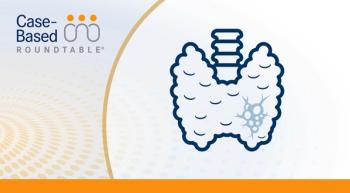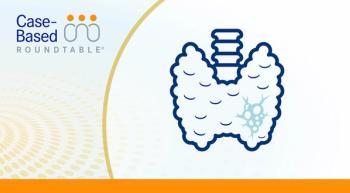
EP. 4B: Understanding Treatment Resistance in First-Generation TRK Inhibitors for the Treatment of NTRK Fusion-Positive Cancers
In this companion article, David S. Hong, MD, considers the safety and efficacy of the first-generation TRK inhibitor larotrectinib and discusses how acquired resistance may affect research into second-generation agents.
In this
Targeted Oncology™: What is the preferred method for detection of NTRK gene fusions and why?
HONG: The ideal/preferred method of NTRK fusion testing is NGS [next-generation sequencing], and preferably RNA-based [NGS]. There are a lot of commercial vendors out there that are DNA-based. I think FoundationOne is DNA-based. There are a number of them. An RNA-based NGS is preferred partly because sometimes the actual fusion partner genes can be much larger than what DNA-based NGS can pick up. Obviously, NGS is catching on at least here in the United States and more and more oncologists can order it. Usually, academic hospitals like The University of Texas MD Anderson Cancer Center have an NGS platform in-house, but there are lots of vendors out there specifically that do this. Foundation Medicine, Caris, and Tempus are all different types of vendors that can do that. In Europe there's usually an algorithm as to when you can order NGS because it’s usually socialized medicine, and they usually have to go through an algorithm where they can get FISH [fluorescence in situ hybridization] testing specifically for certain fusions. After that, if they're negative, then they can get NGS testing, but ideally RNA-based NGS testing.
Targeted Oncology™: When is the best time to perform testing for NGS?
HONG: This is a controversial question. I'm a phase 1 and early development doctor. I would argue that there is increasingly evidence that NGS testing or molecular testing in general should occur as soon as the patient is diagnosed with metastatic cancer or stage IV cancer. Now, not everybody would agree with that because some types of tumors don't really have targeted therapy. There are some diseases where I would argue that it is almost malpractice if you don't get NGS or some kind of wide-based molecular testing, such as lung cancer. We have multiple new therapies now so that if they have that alteration, they can get targeted therapy even in the frontline setting, as in lung cancer.
I think sometimes the challenge is the turnaround time of some of these NGS tests. After you get a biopsy and then send it off, it can take weeks for the turnaround time of it. Some folks would argue that it's better to get local testing, specifically targets that we know can be turned around fairly quickly in local hospitals, such as ALK testing. I would argue that, as soon as a patient is diagnosed with metastatic disease, it would be ideal to get the NGS testing.
Targeted Oncology™: How does the long-term efficacy demonstrated with TRK inhibitors such as larotrectinib compare with other currently available agents?
HONG: The latest data set that we have was from ESMO [European Society for Medical Oncology] 2021 this past year from Dr Alexander Drilon [Memorial Sloan Kettering Cancer Center, New York City, New York]. We were presented this data at ESMO looking at TRK fusion and larotrectinib. We had a total of 218 patients, and this was across a different number of prior lines of therapy. And again, this was all different tumor types across different ECOG [performance statuses], and the overall response rate remained around 75%. Our initial data cutoff showed around 80% response rates. The median duration of response was close to 49 months, median progression-free survival was 35 months, and median overall survival had not been yet reached. I would argue that there is no therapy out there, if you have metastatic cancer, that matches that.
In many ways, I would argue that, if you are a patient who is identified to have an NTRK fusion, it's almost like a lottery ticket because these patients do so well on the study. The full data set did show that patients who had greater than 3 prior lines of therapy had a slightly lower median duration response or progression-free survival than somebody who had no prior therapy up-front. It's expected with the sheer burden of disease. With ECOG [performance status], there seems to be less likelihood of response, but again, that probably has to do with their overall condition and so forth. Overall, If you are able and identified to have an NTRK fusion, I would argue that you need to try to get onto larotrectinib or entrectinib at some point.
Targeted Oncology™: What implication might these results have for patient quality of life? How might that affect your treatment approach in some patients? What does this tell us regarding the importance of testing for NTRK gene fusions?
HONG: We've looked at this quality-of-life issue, we've looked at PROs [patient-reported outcomes] over periods of time, and it clearly shows that these patients do well on this study. From their previous state to actually going on larotrectinib, they have incredible, significant improvement in their overall quality of life. The overall adverse event profiles of these drugs are very benign. Probably the most common side effect tends to be this slight dizziness that patients develop, and over time, they actually get better. There are some grade 3 events such as an increase in LFTs [liver function tests], but usually these adverse events or side effects are manageable. You just hold the drug, you dose reduce them, and they still seem to respond to therapy, at least with larotrectinib. I don't know the data for entrectinib as well, but they're very similar drugs. I would argue that these are very well-tolerated, and their overall quality of life is very good over a period of time.
I'm an investigator, so I do mostly clinical trials, but I think that if patients are identified to have NTRK fusions, whether it's in the frontline setting and even the second-line setting, even though we don't necessarily have randomized data in every single tumor type, given this data at this point, I would argue that it makes sense to try these patients on TRK inhibitors compared with standard chemotherapy, which can be very toxic. In many ways, I see it as almost like a lottery ticket if you're a patient who has this NTRK fusion. It's worth giving larotrectinib or entrectinib a try.
You have to try to find these patients. I think we will find more and more of these patients as NGS testing becomes more common and almost reflexive, particularly in patients with metastatic cancer. I'm sure there are lots of patients out there who probably have NTRK fusions who we’re not identifying. Ideally, we want to identify as many as we can.
Targeted Oncology™: Regarding the on-target and off-target resistance that's been observed with the first-generation TRK inhibitors, how do these resistance mechanisms differ, and which type do you most commonly see in patients?
HONG: There are really 4 different mechanisms of resistance. Again, the king of NTRK, Dr Alexander Drilon, published a great paper in Cancer Discovery looking at these different types of mutations. One is something called solvent-front mutations and gatekeeper mutations. Both of these mutations, differing on where they are, and the third, called xDFG, really kind of affect that near-ATP [adenosine triphosphate] pocket. And then the last kind is the development of alternative pathways, whether it's BRAF or MET. These are alternative signaling pathways that can emerge from mechanisms of resistance.
The solvent-front mutation is probably the most common. Obviously, we don't have a huge number of patients to make that determination at this point, but several years ago we presented some of the data on selitrectinib, which was on this molecule called LOXO-195, which was initially developed by Loxo Oncology and then transitioned to Bayer. And probably the most common subset of patients who became resistant to larotrectinib and entrectinib, the first generation of NTRK inhibitors, was patients with the solvent-front mutation. The second generation tends to work in that group and tends to have efficacy, albeit not as robust as we'd hoped for compared with the first generation. Selitrectinib and also repotrectinib, which is, I think, produced by Turning Point Therapeutics, both target solvent-front and gatekeeper mutations. Selitrectinib also targets xDFG. Both of these drugs tend to have response rates around 40% to 50%, and that may again just be reflective of the disease burden in patients. The data from selitrectinib would also suggest that there was a little bit more toxicity associated with the second generation: more dizziness and ataxia associated with that based upon the April 2020 AACR [American Association for Cancer Research] presentation we gave several years ago. So we'll see what happens. There are other companies that are trying to develop second-generation inhibitors. There's a company called Pyramid Biosciences that is also developing a more brain-penetrant agent but also a molecule that exquisitely targets these solvent-front, gatekeeper, and xDFG mutations. All full disclosure, I'm involved in that trial.
There are hopes that there will be drugs for these patients who become eventually resistant to larotrectinib. The good news is that one of the challenges of these trials is these patients on larotrectinib and entrectinib are on for so long. They're benefiting, like I said; median duration of response was like 45 months, so these patients have been on for so long, and they benefit for so long from the first-generation drugs.
Targeted Oncology™: How effective are the next-generation TRK inhibitors at overcoming resistance to first-generation TRK inhibitors?
HONG: The most recent data sets were from repotrectinib, which is a ROS1/TRK inhibitor. They had a very small, limited data set. I think there were 17 patients in that ACR presentation. The overall response rate was around 45%, 43%, if you combine the phase 1 and 2 results. We will see. I think we'll see larger data sets coming out in the next year or so, and we'll see how response rates stand up. That's compared with the first-generation molecules for which you had response rates in the 80% range.
Targeted Oncology™: What challenges have emerged regarding next-generation TRK inhibitors? What areas of research are further investigating overcoming TRK inhibitor-associated resistance?
HONG: I think the main challenge of doing these trials is identifying new patients. It's been years now, and we've identified 218 patients on the first trial of larotrectinib, and I think that number will start ticking up as NGS becomes more common. But again, with the second generation, because the patients who get the first generation are rare, but also, they do so well. Finding enough patients for the second generation has been always a little bit of a challenge.
I do think that, as most things with targeted therapy, these patients, even in the second generation, may eventually become resistant. So how do we think about the next generation, or how do we improve upon the first generation even more? These are questions that we need to think through as we identify more and more of these patients.









































